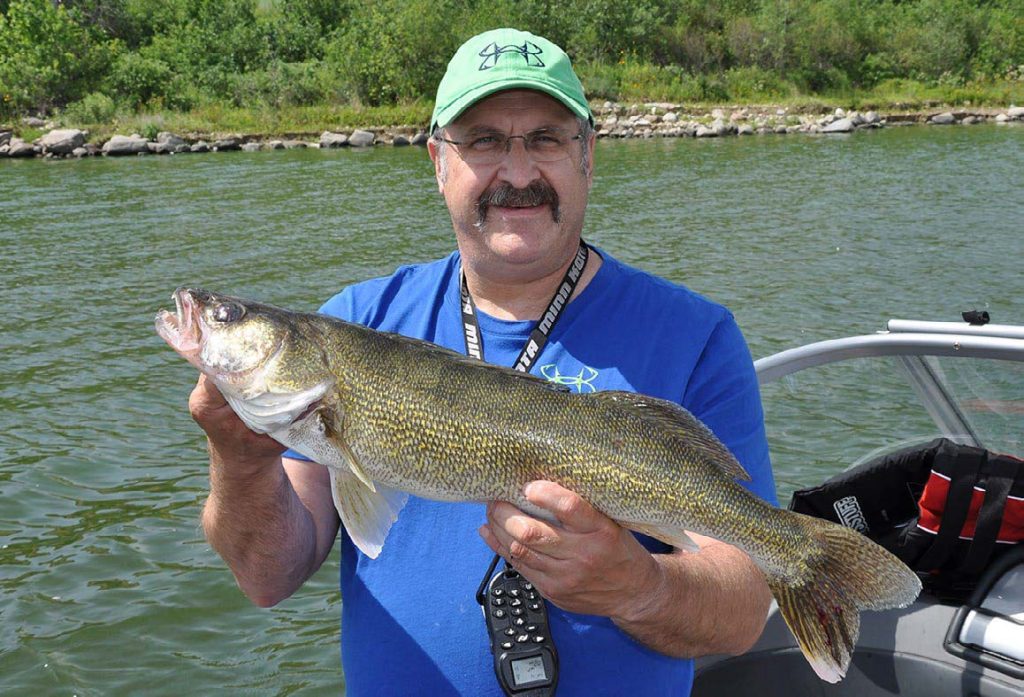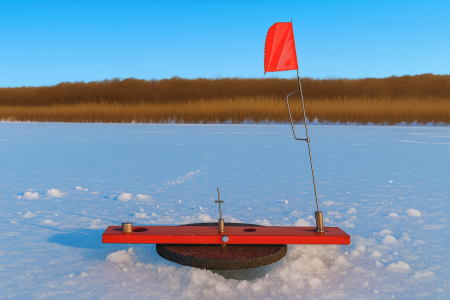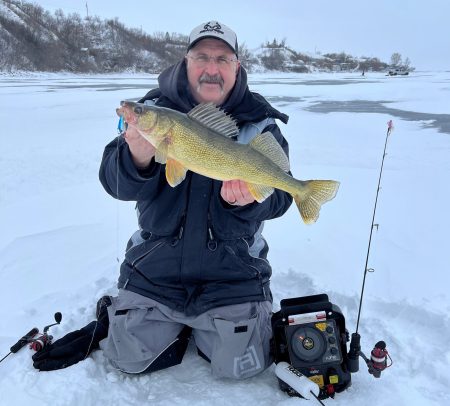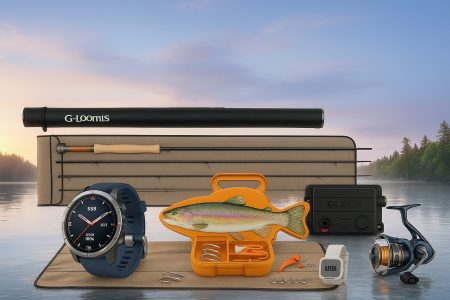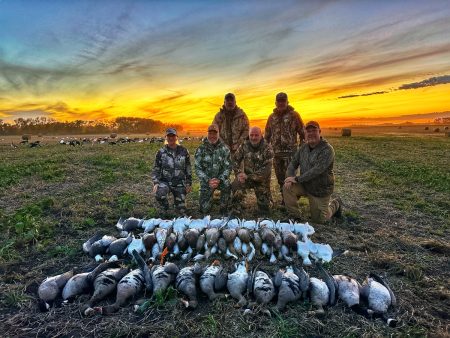For many anglers, the early season timeframe when water temperatures are below 60°F can prove frustrating. The main reason is that they are likely to be focusing their fishing attention on the wrong places, such as mid-summer feeding areas. Or they may be using presentations that are just too big or too quick to entice the early-season walleye to bite.
In March and April, long before the ice has come off lakes and rivers, walleye start to move toward sand bars, rip-rap areas, and high-current locations where they will spawn. Spawning will occur once the ice is gone and the water temperature is above 40°F. Once spawning is over, the fish will start to feed on aquatic creatures inhabiting these areas. As the water temperature starts to approach 50°F, they will move away from spawning areas and disperse to nearby feeding areas with similar water temperatures. They do so to continue feeding to regain strength so they can return next year to spawn.
In many jurisdictions, the fishing season opens up right about the time the walleye begin to move into spring feeding areas. As spring unfolds, the water will slowly continue to warm up. Once the water temperature reaches about 60°F, the fish will move out of their early season feeding areas and into spring and summer feeding areas. That is where most anglers have an easier time patterning them.
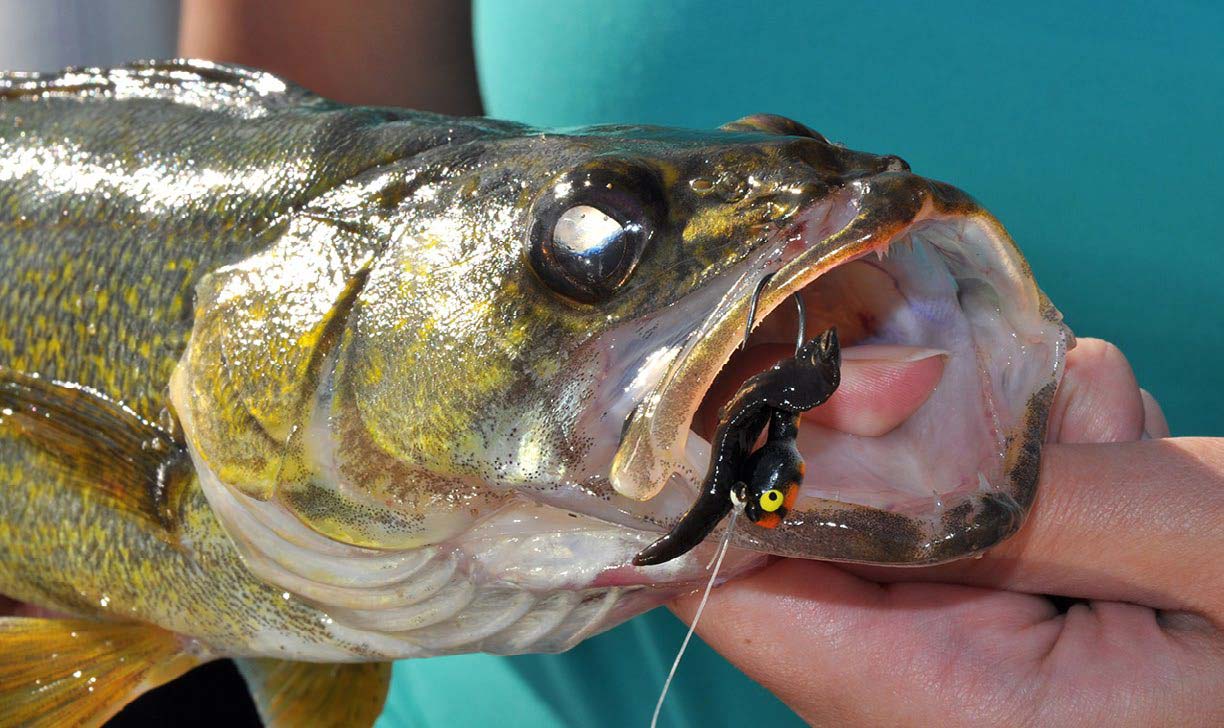
Where to Find Them
Walleye anglers generally talk about fishing structure, ledges and deep holes. While these locations work during the summer, fall and winter, they are generally not prime walleye locations during the early spring season. Savvy early-walleye anglers won’t concentrate on those structure areas, and instead will focus on the warmest water areas they can find. The reason is that as spring unfolds, the warmest areas of a waterbody come to life sooner than other areas of the waterbody do. That results in an abundance of small aquatic creatures and minnows that walleye will heavily prey upon.
Some of the best early-season warm water areas are locations in the three- to 10-foot-depth range. Typically, such areas are along the northern and eastern shorelines, since those areas receive the warmest periods of daily sunshine. When searching for this warm water, look for flooded back bays, dark-bottom mud flats and areas near rocky shorelines with exposed rocks. The rocks will gather the sun’s heat and disperse that warmth to the surrounding water. In addition, look for creek and river mouths where spring runoff brings warmer oxygenated water into the system. In these areas, the water depth may be a little deeper due to erosion from moving water, so don’t shy away from such areas based on the depth.
If you fish the same body of water from year to year, keep a journal of where the water warmed up first. These spots make great starting points to start fishing on your next early-season walleye trip, since they generally produce fish year after year. If fishing a new body of water or looking to expand your areas, take some time before wetting a line to explore and find the warmest water of the day. Water temperature plays a crucial role in helping find walleye this time of year. In fact, an area that is one or two degrees warmer than the rest of the lake can pay huge dividends.
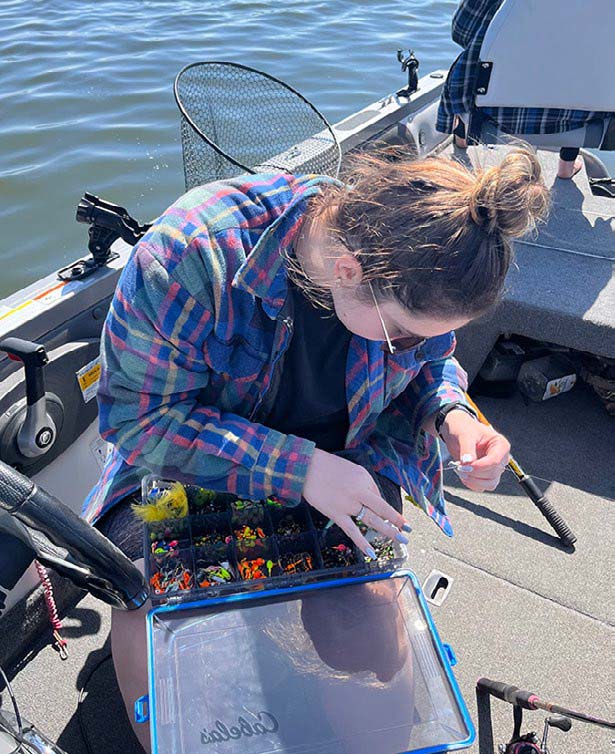
Understanding Temperature
Walleye are cold-blooded creatures, which means their internal body temperature is essentially the same temperature as the water they are swimming in. Even though we are targeting walleye in the warmest water in the system, the early-season water is quite cold. As a result, walleye will typically wait for their food to come right past them. They won’t chase or pursue their food source too far or too quickly since they need to consume more calories than they exert. Knowing this, you can use slow-finesse fishing tactics such as small jigs, slip bobbers or live-bait rigs to target the early-season walleye.
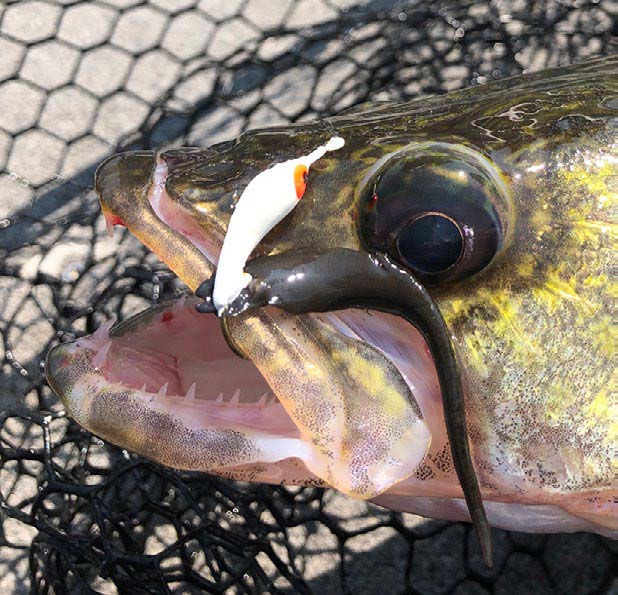
Early-Season Jigging
It is always interesting to see the shallow depths at which early-season walleye can be found. It is very difficult to fish vertically for walleye with jigs when they are in very shallow water. Having your boat sitting over top of them creates unnatural shadows below. No matter how hard you try, you’ll create sound waves that will pass through the boat floor and into the shallow water, causing the fish to spook.
To avoid spooking fish from the shallows, it’s best to anchor up casting distance away from them in slightly deep water. Then, pitch jigs that are tipped with live bait (such as leeches or scented plastics) into the shallows and slowly drag them back to the boat. When doing so, remember that walleye won’t chase your offering if it’s moving too fast. For best results, slowly drag your offering back to the boat. That provides the fish time to inhale it without moving too far or expending a lot of energy to chase it down. During retrieval, you can give your jigs small twitches to add life to them and create flash and sounds to focus the walleye on your jig and bait. When you do that, don’t be overly aggressive. Too big of a jump may move your lure right out of a walleye’s strike zone. Periodically pause your retrieve as well. Let the live bait wiggle and squirm to further entice the walleye.
When using this presentation, don’t expect your jig to get walloped when a walleye hits it. Instead, try to feel the slightest change in tension on your line, and when you feel even the slightest resistance, set the hook. You may encounter a few false alarms doing so, but you will also catch a pile of fish if you get into the practice of setting the hook any time there is a change in pressure on your fishing line.
One of my favorite jig-pitching tactics is to cast my jig so it hits the shoreline just at the point where the water meets land and then start bringing it back to the boat. I really like to do this in areas where there is grass or weeds growing right on the water’s edge. I’m convinced that small creatures go in and out of the water at such locations and that walleye wait and watch for them there.
Over the years, I have found that I have had my best success when using ¼- and ⅜-ounce jig heads. These jig heads are small enough to be able to cast from afar, yet they won’t cause a huge commotion and spook the walleye when they hit the water’s surface.
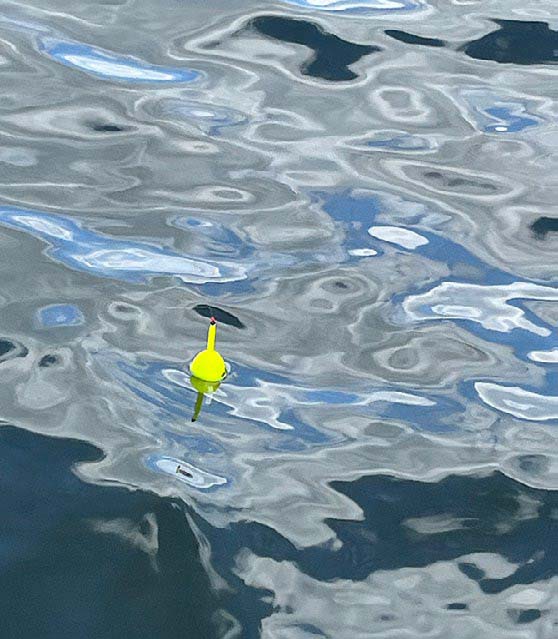
Use Your Eyes
Using a slip bobber is a highly effective presentation that really shines when fishing for early- season, shallow-water walleye. The beauty of using slip bobbers is that they allow you to slowly and naturally suspend your baits. You can drop them directly in the face of sluggish walleye lurking below to where they can’t resist inhaling an easy meal. (Think of this as being like someone holding a bowl of candy in front of your face as you watch TV.)
The visual aspect of watching your bobber disappear into the lake is really very fun and entertaining. In addition, on the coldest days, it is far easier to see a bobber go down than to feel a light bite while retrieving a lure—especially if you’ve got nearly frozen fingertips or you’re wearing a pair of warm, heavy gloves.
When rigging a slip bobber, I like to use a rubber bobber stopper to hold the bobber in place. After putting the bobber stopper on my line, I’ll add a small bead under the bobber stopper. This helps the stopper hold the bobber in place and protects the top of the bobber from damaging the rubber stopper. I slide on the bobber, followed by another bead and a second bobber stopper. The second bobber stopper is then left closer to where I’ll tie on lures. The bobber stopper and bead save my bobber from coming off the line if a pike bites my hook off or if my lure gets snagged in the rocks and breaks off at the knot.
Small jig heads and single hooks work very well to suspend bait under a slip bobber. When setting up a slip bobber rig, use just enough split shot weights or a heavy enough jig so that just the top portion of the bobber is sticking out of the water and the remainder of the bobber is under water. Doing so is what anglers refer to as making the bobber neutral buoyant, which results in the fish not feeling any resistance when they grab the offering. This also allows the angler to see the slightest of bites.
My personal favorite bait with a slip bobber is a lively leech that I hook once through the sucker. I have also used frozen minnows since live minnows are not legal in my home province. I have talked to buddies who are able to use live minnows where they fish. They tell me that hooking a small minnow through the tail works wonders.
In most cases, a walleye will slowly pull the bobber under the water as they take the bait and swim away hugging the bottom. However, in some cases, the walleye will grab the offering and swim upward, causing the bobber to fall over. In either case, give the walleye a few seconds to get your bait and lure fully in their mouth. Then, point your rod tip towards where the bobber was, slowly reel down to take up any slack line, and set the hook the moment you feel pressure.
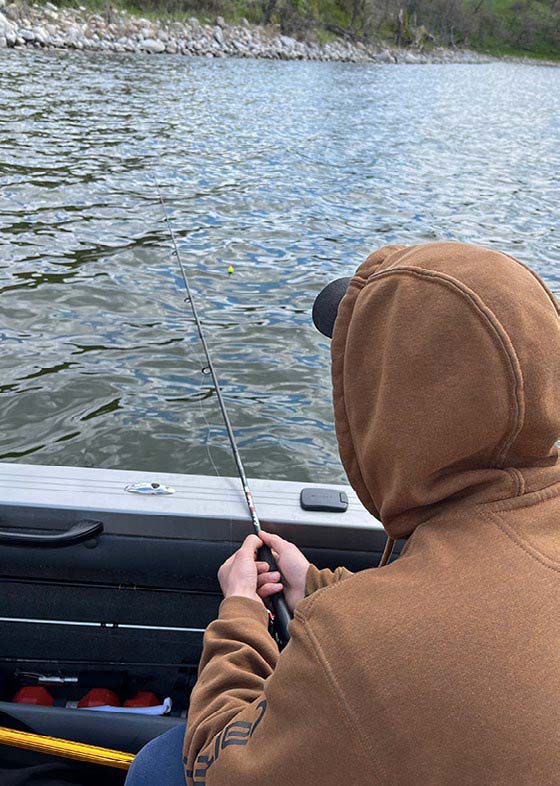
Seek and Find
As the spring progresses, larger portions of the lake will start to warm up into the 50-degree temperature range. When this happens, the walleye will start to spread out and push into these areas. In most cases, these areas will be less than 15 feet of water and have sandy, muddy or rip- rap bottoms. In addition, there may be new weed growth.
While it is still feasible to anchor up and pitch jigs or slip bobbers, it often proves more productive to troll the areas with jigs or live bait rigs, since that allows you to cover more water. When doing so, the key is to move slowly through the area at speeds between 0.2 and 0.5 mph. I have also found that while fishing these shallow water areas, it is more productive to long-line your jigs and live bait rigs behind the boat, versus running the offerings vertically. With the hooks 25 to 30 yards behind the boat, by the time your bait slowly drags past the fish, they will have completely forgotten about your boat going over them and willingly inhale a quick meal.
When pulling jigs, you can go with small lead or tungsten jigs that will drag on the lake bottom and stir up sediment as they travel. Don’t expect the offering to get slammed. Instead, concentrate on your jig. When you feel a slight tap on the line (or if your offering suddenly gets heavier), set the hook immediately.
Live bait rigs with single hooks or floating jig heads are best used with a walking weight system where the fishing line can easily slide through the weight. Use an open bail and hold onto the fishing line. Once a strike is detected, let the line go to allow the fish to take line so that it has a chance to completely take the bait and hook. After a few seconds, close the bail, reel in the slack line, and set the hook as soon as you feel the weight of the fish.
Often while fishing so shallow, I find it hard to mark fish with my Hummingbird Helix– unit as I troll along. So, when someone in the boat hooks a fish, I save that as a waypoint. As the day unfolds and more and more waypoints are laid down, I put together a trolling path that keeps me going over the areas that hold and produce fish.
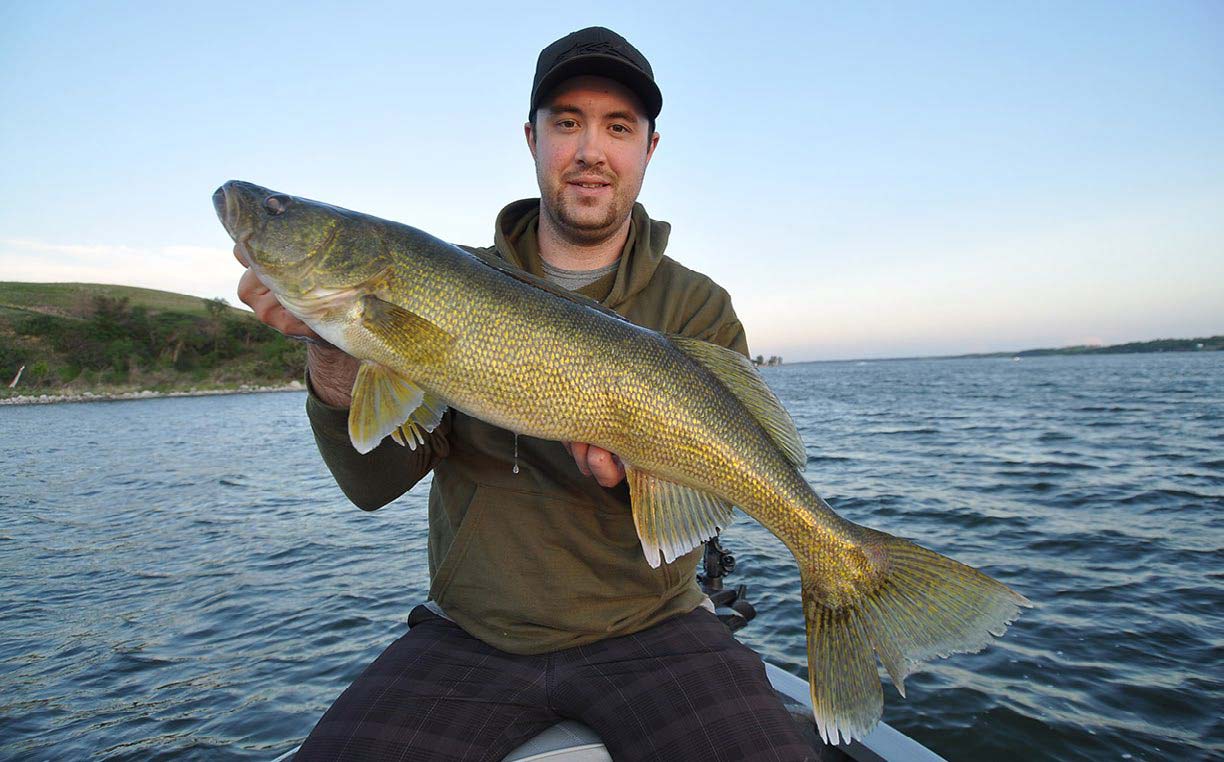
Gearing Up
Shallow-water fishing can be hard on fishing line. Snags occur on a regular basis. Fishing line will be put to the test because it will rub and brush against numerous underwater obstructions. Therefore, when fishing for walleye in shallow water, try to select a fishing line that is tough, durable and nick-resistant, while at the same time being sensitive.
My favorite fishing line for shallow-water, early-season walleye applications is six-pound Berkley Vanish Fluorocarbon. This line meets all my fishing requirements. For fishing rods, I like to use 6’6” to 7’ medium-light to medium action rods for jigging, rigging and slip-bobber fishing. I like a fast tip that allows me to feel the fish bite and have enough backbone power to set the hook and fight fish.
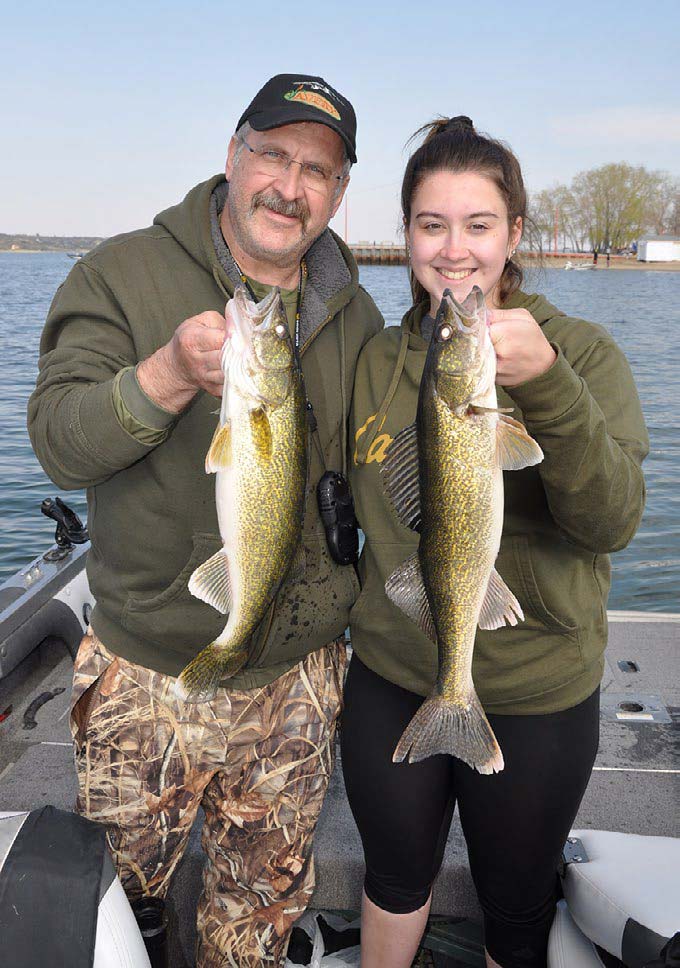
Final Thoughts
Walleye anglers are notorious for being on the water to capitalize on the prime times when walleye are most active. For much of the fishing season, this means fishing during the first and last light timeframes. When it comes to early-season, shallow-water walleye fishing though, some of the best action comes during mid-day periods from about 10 a.m. to 4 p.m., when the sun is high in the sky and it warms up the shallow-water areas.
Anglers who figure out the early-season walleye bite will soon find that they will catch walleye, and that they’ll also catch some big walleye. Many, if not all of the big, early-season walleye caught will be slim, spawned-out females. To help keep your fishery strong for years to come, release any large fish you catch. Chances are they are female fish still recovering from spawning.
Per our affiliate disclosure, we may earn revenue from the products available on this page. To learn more about how we test gear, click here.






